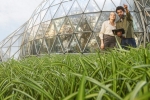Building a more circular economy to add trillions to Australian GDP
AUSTRALIA – A new report by PwC states the case for Australia to ‘go circular’ and wholly embrace sustainable solutions that create an abundant future, finding moves to do so would generate $1.9 trillion in economic benefits over the next 20 years.
According to the report, Building a more circular Australia - The opportunity of transitioning to a circular economy, Australia and the world are facing a serious risk of environmental, health and economic problems unless we fully embrace a new way of doing things.
A “circular economy” is how society makes a wholesale departure from an over-reliance on rapidly-depleting resources, and instead embraces holistic ways of decoupling economic growth from the consumption of finite resources, by driving down waste and pollution, keeping products and materials in use and regenerating natural assets.
“Reversing the current patterns requires a truly holistic approach - which is why a circular economy could be the key to arresting the worrying trends we’re seeing across the planet,” said PwC chief economist Jeremy Thorpe.
Source, Make, Use, Waste - the perils of the linear economy model
“Australia’s growth on a linear model of production has been a story of success and prosperity, but this linear economy has in turn created strain on finite resources and introduced significant quantities of waste, said Thorpe.
“The linear economy is becoming increasingly unsustainable and there is a need for an alternative economy model,” said PwC chief economist Jeremy Thorpe.
“As our population grows, and particularly grows in our cities, we’re seeing more amounts of waste and more emissions. We simply cannot carry our linear economy path any longer. It’s unsustainable, and we need a new alternative economy model.”
The case for change is clear. PwC analysis finds that globally, humankind is effectively running an ecological deficit in terms of its impact on the environment. The analysis reveals that the global economy uses 1.7 planets to produce global output and absorb waste each year.
And here in Australia, the same analysis finds we generate 74 million tonnes of waste per annum - while 90.9 per cent of global raw materials don’t find their way back into the economy.
“This trend is estimated to grow exponentially. If these developments are allowed to continue, the environmental damage caused may become irreversible,” said Thorpe.
A circular economy is the best way forward - both for the environment, and the economy
The PwC report breaks down the high priority opportunities across four key components of a circular economy - and quantifies the benefits to the wider economy.
“Whether it’s rethinking the way we build or making better use of what we already have, changing the way we move by embracing clean energy vehicles or building better connected public transport, adopting new energy consumption habits or turning to green steel for big construction projects, the case for change is clear - not only does it sustain the planet for future generations, it grows our economy too,” said PwC circular infrastructure expert Dr Lucas Carmody.
The circular economy - and how we get there
Initiatives to create a greener and cleaner future are not new. In fact, Governments and policymakers at all levels are attuned to the need to drive more sustainable solutions, but to truly set in motion the transition to a circular economy and reap the potential benefits, only an integrated and comprehensive national framework will do.
“First and foremost, we believe Australia needs to follow the lead of countries such as France, the Netherlands and Scotland, and establish a dedicated and comprehensive circular economy strategy,” said Thorpe.
According to the report, Governments must also step in and regulate market activities in a bid to drive down harmful production activities and find innovative and more efficient ways of doing things.
“This could come in the form of taxes or levies on polluting activities, or incentives for innovative ideas that reduce harm to the environment,” said Thorpe.
For a circular economy to truly take shape, sustainable and attractive markets for second-hand products and materials must also exist.
“The challenge today is that not all second-hand materials are price competitive, but by incentivising the types of economic activity that help nature’s ecosystems rather than deplete them, lawmakers have the power to protect the environment and accelerate the transition to a circular economy,” said Thorpe.
The circular economy - and how infrastructure can help shape it
As Australia embarks on an unprecedented pipeline of infrastructure development demonstrated by $110 billion in transport infrastructure planned by the Federal Government over the next decade, it’s clear that what, why and how we build will play a critical role in shaping our circular economic principles.
The construction and demolition sector in Australia currently accounts for 31 per cent of all waste in Australia, due to the conventional design and construction methods that can lead to significant waste.
“Embracing circular opportunities in the built environment and infrastructure industry is not just about how we design and build for the future, but also retrofitting and encouraging better use in the environment we already have,” said Dr Carmody.
“Incorporating circular opportunities throughout the asset life of infrastructure and the built environment creates value for the economy, provides opportunities for industry to create new revenue streams, products and services, and helps protect the environment.” said Dr Carmody.
To view the report, click here
About PwC
At PwC, our purpose is to build trust in society and solve important problems. We’re a network of firms in 157 countries with over 276,000 people who are committed to delivering quality in assurance, advisory and tax services. Find out more and tell us what matters to you by visiting us at www.pwc.com.
PwC refers to the PwC network and/or one or more of its member firms, each of which is a separate legal entity. Please see www.pwc.com/structure for further details.
© 2020 PwC. All rights reserved














